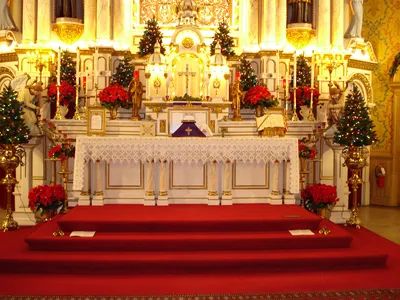L'articolo descrive i vari altari esistenti nelle diverse religioni. Ad esempio, i romani pagani usarono un altare chiamato lararium. Si trovano nelle case e hanno sempre una candela accesa. Fu un altare per il dio Lares. Gli altari cristiani furono fatti di legno e successivamente in pietra. Si credeva che le anime dei defunti vivessero sotto gli altari. L'imperatore Costantino dovette costruire la Basilica di San Pietro sopra un altare in pietra dedicato a San Pietro, appunto, a Roma nel 320 d.C. L'articolo continua descrivendo nel dettaglio le varie parti di un altare e i nomi delle strutture.
As soon as man conceived the idea of offering sacrifices to his Deity, there was a place designated to that end. Primitive altars were of necessity very simple, possibly a heap of stones or earth to hold a fire and the sacrifices. They were commonly constructed in the open air or located on the tops of hills, near large and shady trees or in the woods. The megalithic monuments, such as Stonehenge, left by prehistoric man seem to have been erected for this purpose.
The earliest Scripture reference to altars is from St. Paul where he contrasts the “table of the Lord” on which the Eucharist is offered with the “table of devils,” or pagan altars. This distinction is echoed by St. Cyprian when he references ara and altare, stating that a pagan altar is called ara diaboli, while a Christian altar is altare Dei.
Pagan Altars
Cultic practices were woven into normal life because the pagan altar served as one of the focal points of daily private devotion. The Roman Pagans used a lararium which served as an altar to worship and give offerings to Lares, who were the deities of the home, and to worship the gods of the family and the ancestors who were likely buried there. The Lararium was situated near the hearth and kept lit perpetually. This cult of the hearth has been seen in many ancient cultures and religions, although a mostly forgotten part of pagan domestic worship today.
Christian Altars
The earliest Christian altars were made of wood like ordinary household tables. In 517 C.E., the Council of Epaon, in Gaul, legislated against them and forbade the consecration of any but stone altars. Only a small part of the Christian world recognized this prohibition and wood altars continued to be used for several centuries until there was a growing preference for altars that were more durable.
The idea of stone altars, which later became universal, stems from the custom of celebrating the anniversaries and other feasts honoring those who died for their faith. The custom may have been suggested in the Apocalypse, “I saw under the altar the souls of them that were slain for the word of God.” Martyrs were the confessors of the Faith, Christians who “confessed” Christ before men at the cost of their lives. Hence, the confessio is the tomb, crypt, or relics of a martyr under the high altar. In the beginning of the second century, these were the earliest stone altars, although regular Sunday services were largely held in private homes which served as the churches of that time. Under the pontificate of Pope Damascus (366-384 C.E.,) basilicas and chapels were erected in Rome and elsewhere in honor of the most famous martyrs and the altars were built directly above their tombs.
From 320 and 327 CE., The Emperor Constantine, the first emperor to convert to Christianity, built a basilica directly over St. Peter’s tomb. Though it has had many excavations and renovations over the centuries, most of Saint Peter’s remains are still preserved under the high altar of the Basilica named for him. Also called the Papal Altar, it is deemed one of the holiest spots in all of Christendom.
Ecclesiastical architecture
The high altar is the chief altar in a church, and is elevated in the sanctuary, facing east, where it can be seen by all. It symbolizes Christ and is the sacrificial table on which He offers Himself through the priest to the Eternal Father. He is the sacrifice, and we partake of Him. Mensa is the top of the altar, a natural stone containing relics. The altars of Roman Catholic churches must be consecrated with a saint’s relic. The high altar should be free on all sides, but minor altars may be built against the wall in side chapels.
In a basilica or church, a ciborium is a canopy or covering supported by columns that stands over and covers the altar and the predella, which is where the celebrant stands. Early ciboria had curtains called tetravela used to cover and then reveal the altar during services. Many modern-day churches no longer cover their altars in a ciboria.
The apse is a semicircular or polygonal area behind the altar and at the end of the church opposite the main doors. It is the backdrop for the altar and is an important focus of the church. The apse can include a cross or a crucifix or an altarpiece with an image or statue of the saint the church is named for.
From the earliest beginnings, the altar has been the hierarchical center of the church, the focus of the liturgy that symbolizes the many aspects of Roman Catholic belief: the sacrifice of Christ; the table of the Last Supper; the altar of the Temple in Jerusalem; the cross of Calvary; the tomb of Christ’s burial and his resurrection; and the altar in heaven.
As we begin to think about a church and its meaning, we start with the holy altar, and then allow the rest of the church to harmonize with it. Newly built altars may not be imbued with a sense of the sacred compared to the centuries-old churches and basilicas of Italy, which are majestic and awe-inspiring to behold.
https://www.lagazzettaitaliana.com/history-culture/10323-in-church-altars#sigProId4d6f98e938




